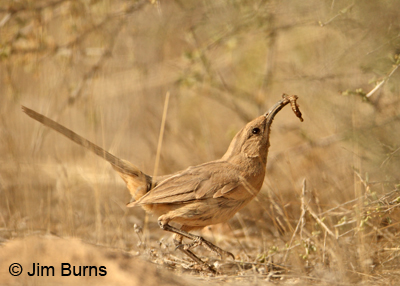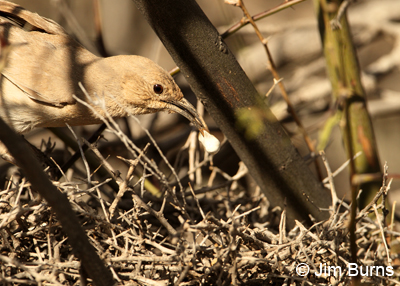
The elation I feel knowing I may be one of the first nature photographers to record the intimate details of Le Conte’s natural history is largely tempered by the dread I feel knowing how easily nature casts aside our species’ imperfect and puny plans. The silvery plumes against the lapis lazuli desert sky remind that Fukushima could happen right down the road from Phoenix. Fukushima tells us, in ways far more chilling than earthquakes and tsunamis, that everything on this planet is interconnected and that we are novices at predicting the consequences of our feeble attempts to subvert and subdue nature.
On this morning the thrashers make twenty-four trips to the nest in four hours. The fare is mostly grasshoppers, caterpillars, and insect eggs sacs, and the nestlings must be close to fledging because nest exits are quick and fecal sac removals few. As I prepare to leave, the last trip I witness by the female (I assume it is she because she always exits downward to the ground and runs away whereas the other parent always exits upward to a singing perch and looks around, then flies away) provides a terrible irony to the morning.
She brings to the launch pad a scorpion which she has captured, beats it on the ground presumably to detach the stinger, then jumps upward to deliver it to her brood. How often do we facetiously suggest that the sole surviving species of a nuclear holocaust will surely be coyote, cockroach, or scorpion, ubiquitous and unloved outliers that live in shadow along the edges of the interface between man and nature? These thoughts intrude as I glimpse again, in my peripheral vision, whatever it is that Palo Verde is spewing.
Not much thrives in this arid, creosote wasteland between Phoenix and the Colorado River. This is, of course, precisely why Palo Verde is located here, close to Phoenix yet far away. Is it far enough? Is there a “far enough away” anywhere on the planet? The Le Conte’s, a species exquisitely evolved to survive the planet’s harshest habitat, are thriving, literally in Palo Verde’s shadow, but neither they nor we are evolved to survive what befell Fukushima.
During the Arizona Breeding Bird Atlas years it was said that ABBA surveyors were the first to ever find and document a Le Conte’s nest but Diane Touret, a Tucson birder, has also found one here this breeding season. Between them, her nest and mine, five young have been produced, and in this small circle of desert where temperatures will soon touch one hundred by ten o’clock in the morning, there are surely more Le Conte’s families. For them and the scorpions it is a circle of life. For better or worse we are part of this circle. The plumes from the Palo Verde plant are an echo of Fukushima, a garish reminder of how easily our species can rend this circle if we do not make informed and proper choices.
